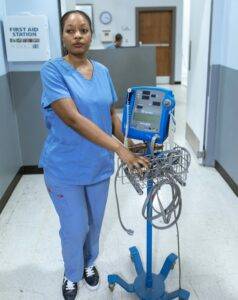In the ever-evolving world of healthcare, nurse practitioners (NPs) play a vital role. They’re often the frontline providers in primary care settings that keep our communities healthy. However, one of the biggest challenges they face today is inadequate staffing.
The issue of inadequate staffing can ripple through various aspects of healthcare, affecting the practitioners themselves and the patients they care for. It affects the NP’s ability to provide high-quality care and impacts their job satisfaction, mental health, and overall well-being.
This comprehensive post will explore the myriad ways inadequate staffing impacts nurse practitioners’ daily work and what measures can be taken to alleviate these issues.
The Crucial Role of Nurse Practitioners in Healthcare
Nurse practitioners are highly trained medical professionals who have completed advanced clinical education. They’re licensed to perform healthcare services in diagnosing and treating illnesses, managing patient treatment plans, and prescribing medications.
They often fill the gap as primary care providers, especially in underserved areas where other healthcare providers are scarce, offering critical services that might otherwise be unavailable. Given their extensive training and expertise, NPs are integral to the healthcare system.
Increasing Responsibility and Scope
Over the years, the scope of practice for NPs has expanded significantly. This expansion reflects the growing recognition of their expertise and their role in healthcare delivery. However, with increased responsibility comes the need for adequate support.
When staffing levels fall short, NPs often find themselves stretched too thin, struggling to meet the demands of their expanded roles.
The Direct Impact on Patient Care
One of the most immediate and visible effects of inadequate staffing is on patient care. Nurse practitioners manage numerous patients, and insufficient staffing exacerbates this challenge.
1. Increased Patient Load
When staffing levels are low, NPs are required to see more patients than they can reasonably handle. This increased patient load leads to rushed appointments, where NPs don’t have the time to fully evaluate each patient, address all concerns, or provide comprehensive care.
For instance, a typical appointment that might require 30 minutes is shortened to 15 minutes or less. This reduces the time available for thorough examination and limits the opportunity for patient education, which is crucial for effective treatment and disease prevention. This situation underscores the rippling effect of inadequate staffing.
2. Decreased Quality of Care
Inadequate staffing further manifests in decreased quality. Rushed appointments and high patient volumes increase the risk of errors. Nurse practitioners miss critical details in patient histories or fail to catch early signs of serious conditions. Furthermore, the ability to follow up with patients is compromised, leading to poorer health outcomes.
Chronic conditions, in particular, require detailed management plans and consistent monitoring. Inadequate staffing hinders NPs’ ability to provide follow-up and monitoring, which is essential for managing diseases like diabetes, hypertension, and asthma.
3. Impact on Preventive Care
Preventive care is a cornerstone of primary healthcare. It involves regular check-ups, screenings, and patient education to prevent diseases before they occur. However, with a heavy patient load compounded with inadequate staffing, preventive care takes a backseat.
NPs may not have time to conduct thorough screenings or educate patients on lifestyle changes, which leads to a higher incidence of preventable diseases.
Effects on Nurse Practitioners’ Job Satisfaction and Mental Health
The pressures of inadequate staffing extend beyond patient care, significantly affecting the well-being of nurse practitioners.
4. Burnout and Stress
Nurse practitioners working in understaffed environments are at a high risk of burnout. This is characterized by physical and emotional exhaustion, feelings of detachment, and a sense of ineffectiveness.
The constant pressure to see more patients, compounded with the emotional toll of providing care under challenging conditions, leads to significant stress and burnout. Burnout affects the NPs’ health and their performance.
Studies have shown that burnout leads to decreased job performance, increased errors, and higher turnover rates. This creates a vicious cycle, where staffing shortages lead to burnout, resulting in more staffing shortages.
5. Job Dissatisfaction
When nurse practitioners can’t provide the quality of care they aspire to due to staffing issues, job satisfaction plummets. This dissatisfaction leads to high turnover rates, further exacerbating staffing shortages. High turnover disrupts patient care continuity and increases the burden on remaining staff members.
6. Mental Health Concerns
Chronic stress and burnout have serious implications for NPs’ mental health. Conditions such as depression and anxiety are prevalent among healthcare providers working in understaffed environments. Addressing these mental health concerns is crucial, as they affect the well-being of NPs and their ability to provide high-quality care.
Impact on Work-Life Balance
Inadequate staffing affects the professional and personal lives of nurse practitioners
7. Extended Work Hours
To meet patient demands, NPs work extended hours, including evenings and weekends. This encroaches on personal time, leading to strained relationships and a poor work-life balance. Their inability to disconnect from work leads to chronic fatigue and decreased job satisfaction.
8. Limited Time for Continuing Education
Staying updated with the latest medical knowledge is essential for nurse practitioners. However, finding time for continuing education and professional development is challenging with inadequate staffing. This affects the quality of care, as they may not be up-to-date with the latest treatment guidelines and medical advancements.
Strategies to Address Inadequate Staffing
Addressing inadequate staffing requires a multifaceted approach involving healthcare institutions, policymakers, and NPs themselves.
1. Policy Changes and Advocacy
Advocating for policy changes at the state and national levels helps address staffing issues. This includes pushing for better nurse-to-patient ratios and adequate funding for healthcare institutions to hire sufficient staff.
Policymakers should recognize the importance of adequate staffing to ensure high-quality patient care and the well-being of healthcare providers.
2. Enhancing Recruitment and Retention
Healthcare institutions should focus on enhancing recruitment and retention efforts. This includes offering competitive salaries, opportunities for professional development, and creating a supportive work environment that values work-life balance.
Retention strategies also involve mentoring programs, leadership opportunities, and recognition of the critical role NPs play in healthcare.
3. Utilization of Support Staff
Utilizing support staff, such as medical assistants and nurse aides, helps alleviate the burdens on NPs. These support staff can handle routine tasks, allowing NPs to focus on more complex patient care needs. Effective delegation improves efficiency and allows NPs to provide more comprehensive care.
4. Telehealth and Technology
Incorporating telehealth and other technological solutions helps manage patient loads more effectively. Telehealth allows NPs to provide care remotely, which is beneficial in managing follow-ups and chronic conditions. Technology also streamlines administrative tasks, allowing NPs to spend more time on direct patient care.
5. Team-Based Care
Implementing a team-based care approach distributes the workload evenly among healthcare providers. In this model, NPs, physicians, nurses, and other healthcare professionals work collaboratively to manage patient care. This enhances efficiency, improves patient outcomes, and reduces the burden on individual providers.
6. Improving Workflow Efficiency
Improving workflow efficiency within healthcare settings also mitigates the impact of inadequate staffing. This involves optimizing scheduling systems, reducing unnecessary paperwork, and utilizing electronic health records effectively. By streamlining processes, NPs have more time to focus on patient care.
7. Supporting Mental Health
Providing mental health support for nurse practitioners is crucial in addressing the stress and burnout brought about by inadequate staffing.
This includes counseling services, stress management programs, and creating a work environment that promotes mental well-being. Encouraging open communication and providing resources for mental health help NPs cope with the demands of their job.
Case Study: Successful Strategies in Action
Let’s consider a case study of a healthcare institution that successfully addressed inadequate staffing and its impact on nurse practitioners.
The Challenge
A community health clinic faced significant staffing shortages, leading to high patient volumes and increased stress among NPs. Patient care quality was compromised, and turnover rates were high. The clinic recognized the need for immediate action to address these challenges.
The Solution
The clinic implemented several strategies to improve staffing levels and support NPs. They advocated for policy changes on nurse-to-patient ratios and secured additional funding to hire more staff. They also enhanced recruitment efforts by offering competitive salaries and professional development opportunities.
The clinic optimized scheduling systems and reduced unnecessary paperwork to improve workflow efficiency. They utilized telehealth to manage follow-ups and chronic conditions, reducing the burden on NPs. Support staff were hired to handle routine tasks, allowing NPs to focus on complex patient care.
The Outcome
As a result of these efforts, the clinic saw a significant improvement in staffing levels and a reduction in patient volumes for individual NPs. This results in improved patient care quality, higher job satisfaction, and lower turnover rates. NPs reported feeling more supported and capable of providing comprehensive care to their patients.
Real-Life Impact: Stories from Nurse Practitioners
To truly understand the impact of inadequate staffing, hear from nurse practitioners. Here are a few stories from NPs who have experienced the challenges firsthand.
Emma’s Story
Emma, a nurse practitioner in a rural community, shares her experience: “In our clinic, we were always short-staffed. I had days when I saw over 30 patients. It was exhausting, and I felt like I was constantly playing catch-up. There was no time for thorough patient education or preventive care.
It was heartbreaking because I knew my patients deserved better.” Emma’s story highlights the real-world implications of inadequate staffing, particularly in underserved areas. The lack of time for comprehensive care affects patient outcomes and severely impacts NPs’ emotional and physical health.
Michael’s Journey
Michael, an NP in an urban hospital, recounts his journey: “The high patient volume and constant pressure led to burnout. I started feeling detached from my work and my patients. It was a tough decision, but I eventually left the hospital for a less demanding job. The healthcare system lost another provider because of staffing issues.”
Michael’s experience underscores the importance of addressing burnout and supporting NPs to prevent high turnover rates. Losing experienced providers due to burnout further exacerbates staffing challenges and impacts patient care continuity.
Looking Forward: Building a Sustainable Future
As we look to the future, let’s build a sustainable healthcare system that supports nurse practitioners and other healthcare providers. This involves addressing current staffing issues and planning for future needs.
Investing in Education and Training: Investing in the education and training of future nurse practitioners is crucial. This includes expanding nursing programs, providing scholarships and financial aid, and offering mentorship opportunities. By increasing the:e number of trained NPs, we help address the staffing shortages and ensure a robust healthcare workforce for the future.
Promoting a Culture of Wellness: Promoting a culture of wellness within healthcare institutions is essential for supporting NPs’ mental and physical health. This includes creating a supportive work environment, offering wellness programs, and encouraging work-life balance. By prioritizing the well-being of healthcare providers, we improve job satisfaction and retention rates.
Embracing Innovation: Innovation in healthcare, including the use of technology and new care models, helps address staffing challenges. Telehealth, for example, has proven to be a valuable tool in managing patient care efficiently. Embracing such innovations enhances the capacity of NPs to provide high-quality care despite staffing limitations.
Support Nurse Practitioners by Addressing The Issue of Inadequate Staffing
Inadequate staffing in healthcare is a multifaceted issue that requires immediate attention and action. The impact on nurse practitioners, patient care, and the healthcare system is profound.
Inadequate staffing is a critical issue that impacts nurse practitioners’ daily work. We can create an effective healthcare environment by understanding the challenges and working collaboratively towards solutions. We help ensure that NPs are adequately supported to provide the highest quality of care to the patients.
Let’s work together to support our nurse practitioners and ensure the best possible care for our patients. For related topics, check out these articles on Omega Pediatrics:
- The Impact of Telemedicine on Pediatric Care
- Outstanding Pediatric Careers: Reasons to Work with Omega Pediatrics
For those interested in learning more about the challenges and solutions related to healthcare staffing, the following resources may be helpful:
- American Association of Nurse Practitioners (AANP)
- National Institute for Occupational Safety and Health (NIOSH)
- Healthcare Workforce Shortages: Solutions and Strategies
Addressing the staffing challenges faced by nurse practitioners is crucial for the sustainability of our healthcare system. With concerted efforts, we create a supportive environment that allows NPs to thrive and provide the best possible care to their patients.







